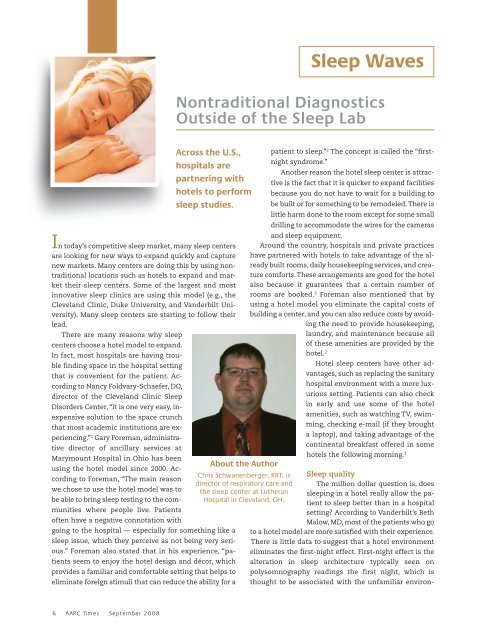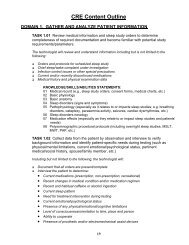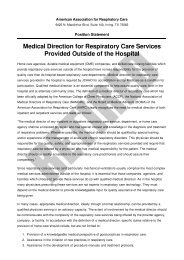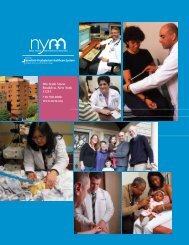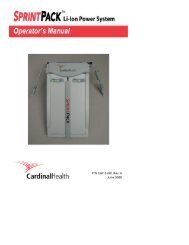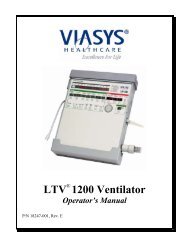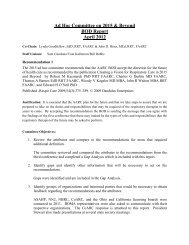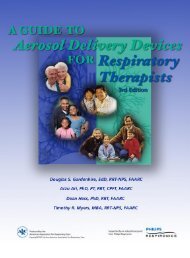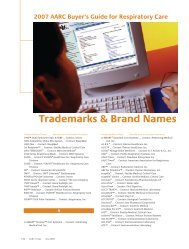Sleep Waves - American Association for Respiratory Care
Sleep Waves - American Association for Respiratory Care
Sleep Waves - American Association for Respiratory Care
Create successful ePaper yourself
Turn your PDF publications into a flip-book with our unique Google optimized e-Paper software.
In today’s competitive sleep market, many sleep centers<br />
are looking <strong>for</strong> new ways to expand quickly and capture<br />
new markets. Many centers are doing this by using nontraditional<br />
locations such as hotels to expand and market<br />
their sleep centers. Some of the largest and most<br />
innovative sleep clinics are using this model (e.g., the<br />
Cleveland Clinic, Duke University, and Vanderbilt University).<br />
Many sleep centers are starting to follow their<br />
lead.<br />
There are many reasons why sleep<br />
centers choose a hotel model to expand.<br />
In fact, most hospitals are having trouble<br />
finding space in the hospital setting<br />
that is convenient <strong>for</strong> the patient. According<br />
to Nancy Foldvary-Schaefer, DO,<br />
director of the Cleveland Clinic <strong>Sleep</strong><br />
Disorders Center, “It is one very easy, inexpensive<br />
solution to the space crunch<br />
that most academic institutions are experiencing.”<br />
1 Around the country, hospitals and private practices<br />
have partnered with hotels to take advantage of the already<br />
built rooms, daily housekeeping services, and creature<br />
com<strong>for</strong>ts. These arrangements are good <strong>for</strong> the hotel<br />
also because it guarantees that a certain number of<br />
rooms are booked.<br />
Gary Foreman, administrative<br />
director of ancillary services at<br />
Marymount Hospital in Ohio has been<br />
using the hotel model since 2000. According<br />
to Foreman, “The main reason<br />
we chose to use the hotel model was to<br />
be able to bring sleep testing to the communities<br />
where people live. Patients<br />
often have a negative connotation with<br />
going to the hospital — especially <strong>for</strong> something like a<br />
sleep issue, which they perceive as not being very serious.”<br />
Foreman also stated that in his experience, “patients<br />
seem to enjoy the hotel design and décor, which<br />
provides a familiar and com<strong>for</strong>table setting that helps to<br />
eliminate <strong>for</strong>eign stimuli that can reduce the ability <strong>for</strong> a<br />
3 Foreman also mentioned that by<br />
using a hotel model you eliminate the capital costs of<br />
building a center, and you can also reduce costs by avoiding<br />
the need to provide housekeeping,<br />
laundry, and maintenance because all<br />
of these amenities are provided by the<br />
hotel. 2<br />
Hotel sleep centers have other advantages,<br />
such as replacing the sanitary<br />
hospital environment with a more luxurious<br />
setting. Patients can also check<br />
in early and use some of the hotel<br />
amenities, such as watching TV, swimming,<br />
checking e-mail (if they brought<br />
a laptop), and taking advantage of the<br />
continental breakfast offered in some<br />
hotels the following morning. 3<br />
About the Author<br />
Chris Schwanenberger, RRT, is<br />
director of respiratory care and<br />
the sleep center at Lutheran<br />
Hospital in Cleveland, OH.<br />
<strong>Sleep</strong> quality<br />
The million dollar question is, does<br />
sleeping in a hotel really allow the patient<br />
to sleep better than in a hospital<br />
setting? According to Vanderbilt’s Beth<br />
Malow, MD, most of the patients who go<br />
to a hotel model are more satisfied with their experience.<br />
There is little data to suggest that a hotel environment<br />
eliminates the first-night effect. First-night effect is the<br />
alteration in sleep architecture typically seen on<br />
polysomnography readings the first night, which is<br />
thought to be associated with the unfamiliar environ-<br />
6 AARC Times September 2008<br />
<strong>Sleep</strong> <strong>Waves</strong><br />
Nontraditional Diagnostics<br />
Outside of the <strong>Sleep</strong> Lab<br />
Across the U.S.,<br />
hospitals are<br />
partnering with<br />
hotels to per<strong>for</strong>m<br />
sleep studies.<br />
patient to sleep.” 2 The concept is called the “firstnight<br />
syndrome.”<br />
Another reason the hotel sleep center is attractive<br />
is the fact that it is quicker to expand facilities<br />
because you do not have to wait <strong>for</strong> a building to<br />
be built or <strong>for</strong> something to be remodeled. There is<br />
little harm done to the room except <strong>for</strong> some small<br />
drilling to accommodate the wires <strong>for</strong> the cameras<br />
and sleep equipment.
<strong>Sleep</strong> <strong>Waves</strong> Nontraditional Settings<br />
ment and the technical equipment. In a report in the Journal<br />
of Clinical <strong>Sleep</strong> Medicine, it is suggested that the hotel<br />
model does not eliminate the first-night effect and that<br />
patients do not sleep any better in the hotel setting than<br />
in the hospital’s main sleep center. Kimberly N. Hutchinson,<br />
MD, and colleagues from Vanderbilt University Medical<br />
Center in Nashville, TN, conducted a study of 49<br />
patients in their hotel-based laboratory and 44 patients<br />
in a hospital-based laboratory. They predicted that the<br />
changes in sleep architecture consistent with the firstnight<br />
effect would be greater in the hospital than in the<br />
hotel patients. The sleep parameter <strong>for</strong> the hotel-based<br />
patients did not differ from those of the hospital-based<br />
patients. 4<br />
Disadvantages<br />
There are some disadvantages and challenges when<br />
setting up a sleep center in a hotel, the first of which is<br />
convincing the hotel management that this is a good idea<br />
and there would be little damage to the rooms. Another<br />
obvious challenge would be the possibility of loud guests<br />
and traffic in the hallways. Some large centers may rent<br />
an entire floor or section of the hotel. Vanderbilt uses<br />
seven rooms at one end of Marriott’s fifth floor, and doors<br />
labeled Vanderbilt’s <strong>Sleep</strong> Disorders Center separates the<br />
sleep center from the rest of the guest rooms. 1 In Foreman’s<br />
labs they rented three rooms — one <strong>for</strong> the control<br />
room and two patient-sleeping rooms. They did have<br />
some trial and error at one of the hotels that they used;<br />
they had to move from their first location due to the excess<br />
traffic and noise. However, they were moved to a<br />
quieter section of the hotel, and things were fine. 2<br />
Another disadvantage is trying to outfit the room <strong>for</strong><br />
all of the equipment. Most labs require some small<br />
drilling <strong>for</strong> the wires <strong>for</strong> the cameras and the sleep equipment.<br />
This may take some convincing <strong>for</strong> the hotel management<br />
but can be accomplished quite easily. Foreman<br />
said, “They had adjoining rooms that seemed to help, and<br />
they actually ran the wires along the baseboards and<br />
under the door, thus eliminating the need <strong>for</strong> drilling<br />
holes.”<br />
Patient safety concerns<br />
One of the biggest concerns when you think of doing<br />
sleep studies in a hotel is ensuring patients’ safety. Foreman<br />
stated, “One of the first things that they did was to<br />
ensure that they had all of the emergency resuscitation<br />
supplies needed <strong>for</strong> a sleep lab. They had good communication<br />
with the hotel management, explaining that<br />
they were conducting medical testing in those hotel<br />
rooms and what to expect in case of an emergency and<br />
8 AARC Tımes September 2008<br />
The newest and most<br />
controversial topic in sleep<br />
medicine is home sleep<br />
testing.<br />
the need to call 911. They contacted the local emergency<br />
medical squads and the local fire department to in<strong>for</strong>m<br />
them that they were conducting medical testing in the<br />
hotel and in which specific rooms. They also worked with<br />
the hotel and created policies and procedures together,<br />
and they participated in the hotel’s fire drills and included<br />
the hotel in their own emergency drills.” 2<br />
Another safety mechanism was the fact that each<br />
hotel room outfitted <strong>for</strong> sleep testing had a camera in it<br />
so the technician could see into the patient’s room to ensure<br />
that they were safe during the test. All of the tests<br />
were also recorded so that when the technician entered<br />
the room, what happened in the room was recorded to<br />
ensure safety <strong>for</strong> the staff and the patient. 2
Another factor when using the hotel sleep center is<br />
making sure that the appropriate sleep patients are seen<br />
in the location best suited <strong>for</strong> them based on the patient’s<br />
history and co-morbidities. At Foreman’s lab they<br />
developed a good screening mechanism where the physician<br />
and the sleep technicians would review all of the patient’s<br />
history and physical to determine if they were<br />
appropriate <strong>for</strong> the hotel sleep lab. If the physicians had<br />
any concern about the patients, they were set up in the<br />
hospital’s main sleep center located at the hospital. 2<br />
Home testing<br />
The newest and most controversial topic in sleep<br />
medicine is home sleep testing. The approved Centers <strong>for</strong><br />
Medicare and Medicaid Services (CMS) decision memo<br />
that allows coverage <strong>for</strong> home sleep studies was released<br />
this spring (see www.cms.hhs.gov/mcd/viewdecision<br />
memo.asp?from2=viewdecisionmemo.asp&id=204&).<br />
The National Coverage Determination and Local Coverage<br />
Determination rules are not out yet. Some of the<br />
highlights of the memo include a new 12-week continuous<br />
positive airway pressure (CPAP) trial period <strong>for</strong> beneficiaries<br />
diagnosed with obstructive sleep apnea (OSA)<br />
whose OSA improved as a result of CPAP during this 12week<br />
period. Another change is that polysomnography is<br />
no longer considered the “gold standard” <strong>for</strong> OSA. A clinical<br />
evaluation and a Type II, Type III, and Type IV home<br />
device (must have three channels) may now qualify<br />
Medicare patients <strong>for</strong> CPAP. Limits to both the apneaplus-hypopnea<br />
index and the respiratory disturbance<br />
index have been redefined.<br />
The CMS decision memo leaves a lot of unanswered<br />
questions about how to effectively implement the new<br />
policy. It is unclear whether CMS or individual Local Coverage<br />
Determinations will define the following rule <strong>for</strong><br />
“Physician Qualified” to interpret home sleep studies. The<br />
definition of “clinical evaluation” remains undefined. The<br />
definition of the benefit or improvement of the 12-week<br />
CPAP trial period is also very vague. It is uncertain how<br />
this decision will affect many sleep centers, but it appears<br />
home testing is indeed here to stay and will have a<br />
big effect. 5<br />
Options to expand<br />
Hotel sleep centers appear to be a cost-effective way<br />
to expand and market sleep centers. Hotel sleep centers<br />
can be built quickly and strategically placed within the<br />
communities that you wish to serve, and this can be accomplished<br />
with careful planning and cooperation with<br />
the hotel partner. This should increase your patients’<br />
<strong>Sleep</strong> <strong>Waves</strong> Nontraditional Settings<br />
satisfaction while maintaining a safe environment <strong>for</strong><br />
patients and staff.<br />
Home sleep studies will be an interesting topic over<br />
the next few years, and it is important <strong>for</strong> respiratory<br />
therapists and sleep technicians to be involved in sleep<br />
testing in the home. ■<br />
REFERENCES<br />
1. Advance For <strong>Sleep</strong> web site. Checking in: hotel-based sleep centers<br />
may be future of testing. Available at: http://sleep-medicine.<br />
advanceweb.com/Editorial/content/Printfriendly.aspx?CC=69532<br />
Accessed June 3, 2008<br />
2. Foreman G. Administrative director respiratory care and ancillary<br />
services, Marymount Hospital. Interview, June 2008.<br />
3. Fredericksburg.com web site. <strong>Sleep</strong> tests move to comfy quarters.<br />
Available at: http://fredericksburg.com/News/FLS/2007/122007/<br />
12092007/319877 Accessed July 17, 2008<br />
4. Clinical Lab Products web site. Hotel-based sleep study does not<br />
eliminate “first-night” effect. Available at: www.clpmag.com/reuters_<br />
article.asp?id=20080425clin006%2Ehtml Accessed July 17, 2008<br />
5. Valenza T. <strong>Sleep</strong> Review web site. Home sleep testing: present position<br />
and predictions. Available at: www.sleepreviewmag.com/issues/<br />
articles/2008-06_09.asp Accessed July 31, 2008<br />
AARC Tımes September 2008 9


